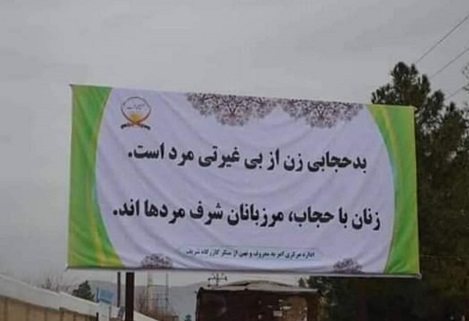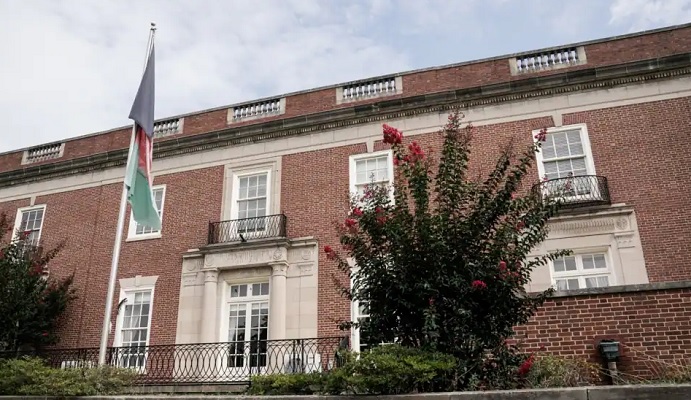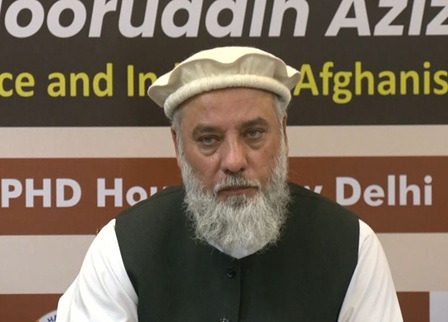
Photo: Mujib Rahman Ansari, a popular Islamic extremist and a religious clerk in the western Herat province installed dozens of billboards and signboards around the city, targeting Afghan women, urging them to wear Islamic Hijab.
Salafism is going to encompass all of Afghanistan
By: Saleem Payenda
Those who cross Shah Dushamshira Street (The street of downtown Kabul now called “Farkhonda“) will never be able to not remember “Farkhonda” once. Farkhonda was a young girl killed in the most outrageous manner by a number of angry and religious people on March 1, 2009.
A group of unwise men, provoked by the Mullah of Shah Do Shamshira’s, (the shrine of Liath ibn Qais bin Abbas, an Arab religious figure in afghanistan), rebelled against Farkhonda on the charge of burning the Koran and killed her under a fist and throwing the stones. They then drove car on her dead body and finally burned her body near the

Kabul River. After the grievous murder incident, Farkhonda was found to have no guilt and even she was a religiously educated girl, she became a symbol of the victims of ruthlessly violent religious extremism. In the area where she was killed, built a memorial minaret and is commemorated on March 5 each year. But the assassination of Farkhonda once again heightened the chaos of the rise of extremism in the social layers. Many also warned of intensifying religious extremism in Afghanistan in those days. But nothing more than a few media articles and a few reports were come. Now, more than five years after her death, fears have been raised about the unnecessary growth of extremism in Afghanistan. This time too, a Salafist-Quietist mullah’s reaction in western Afghanistan on the type of hijab of women has led to the rise of extremism in social and media circles in Afghanistan.
Not long ago, Afghan religious clerk warns to punish women who disregard Islamic Hijab.
Mullah Mujib Rahman Ansari, a Salafist mullah in Herat city, what he considered as ” Increasing of prostitution” in Herat, He responded by saying that if he saw in his area north of the city of Herat a boy and a girl circling outside the framework of blood-relations and customs, he would be imposed Hudud (religion punishments of Islamic law (shariah) on them. He named the walking of girls and boys “adultery” and called on his supporters to execute “Islamic law” on anyone who saw them in the city.
Subsequently, Mawlawi Hanif, the parliament member, also said in a statement that 100 percent of those leaving their homes on Friday were in violation of public morality. Of course, he later apologized for what he said and described the result as a border of rage. The same remarks and statements reflect his attitude toward those who view Friday as a hike and to be a walk. Subsequently, supporters of Mullah Mujib Rahman Ansari mounted billboards in Herat city that read, “Women without hijab have husbands without zeal”.
The uproar that ensued showed that concern for the rise of extremism in society was slowly becoming a nightmare.
How does moderate Islam become radical Islam?
Throughout post-Islamic history, the people of Afghanistan have been associated with a kind of traditional balanced Islam that derives from the influence of custom and social traditions on society. The structure of society in Afghanistan is the result of the integration of religion and social traditions. The Afghan nation is made up of various tribes and groups, and the status of the “tribe” and its affiliations is still strong in the social structure. Tribal customs and traditions have also largely overshadowed people’s religious beliefs. On the other hand, the majority of people in Afghanistan follow the Hanafi Islam, and everyone knows that Imam Abu Hanifa was one of the most balanced and moderate jurisprudentialists.
For this reason, until the 1980s, views such as Wahhabism of Saudi Arabia and the Salafism of India and Pakistan had little effect on the religious culture of the people in Afghanistan. When King Mohammad Zahir Shah made the veil optional and a number of women discovered the veil, religious scholars did not stand up to it, and for years the veil was accepted as an optional tradition in Afghanistan. Following the May 7 coup of leftist officers in Afghanistan and the coming of the former Soviet-backed regime, religious “jihad” as a rally ignited the flames of war in Afghanistan. In addition to US support for the Mujahidin’s battles against the government and the former Soviet forces, the Arabs and Pakistanis have not only provided much mujahideen aid to the jihadists in Afghanistan, but have also been in the barricades themselves. With the presence of Arabs, attitudes of Wahhabism and Salafism in Afghanistan have also become widespread. A large number of Afghans in Pakistan’s religious madrasas where Salafism was taught increased their influence in Afghanistan. Saudi Arabia also brought a number of Afghan mullahs to Saudi Arabia to speak out against the influence of the Islamic Republic of Iran in Afghanistan, where it provided them with the opportunity to teach Salafism. Returning to the country, these mullahs became fierce Salafist propagandists in Afghanistan, and their influence and attitudes have now reached such a level that the Hanafi religion in Afghanistan is stepping back.
“The concern is that the government is not taking any action. Governments have been unable to respond to the rapid growth of extremism over the past eighteen years because of continued clashes with the Taliban and military opposition, fearing the opening of a new front in the cities. The fear continues, even though it is well-known that Salafist followers in Afghanistan make it possible for the Taliban to recruit.” Written Nasima Bari, an afghan human rights activist in southern afghanistan, who recently published a book ‘the monster’s shadow’ in Pashto language which explain how the religious and social extremism threat afghan society and women rights. Salafist movements, such as Hizb ut-Tahrir and the Jamiat-E Eslah, while opposing Taliban methods, are generally the same, and these movements, consciously or unconsciously, pave the way for Taliban recruitment in Afghanistan. These movements, far more dangerous than the Taliban, have targeted academic and educational institutions. So far several university professors have been detained by security agencies on charges of promoting extremism and even fighting the government, but the process of bolstering Salafism in Afghanistan has not stopped. While responses and reactions on social media to some extent compel them to give up their bitter views occasionally, the reality is that extremism is taking wider and faster steps to fully dominate the geography of Afghanistan and these steps can put Afghanistan’s complex social structure in dangerous turmoil.
(Saleem Payenda is a research fellow of International Relations at the University of Mysore, India. writes on Afghanistan’s foreign policy, state-building, socio-political and economic and human rights issues. tweets @saleempayenda, he can be contacted at [email protected] )






